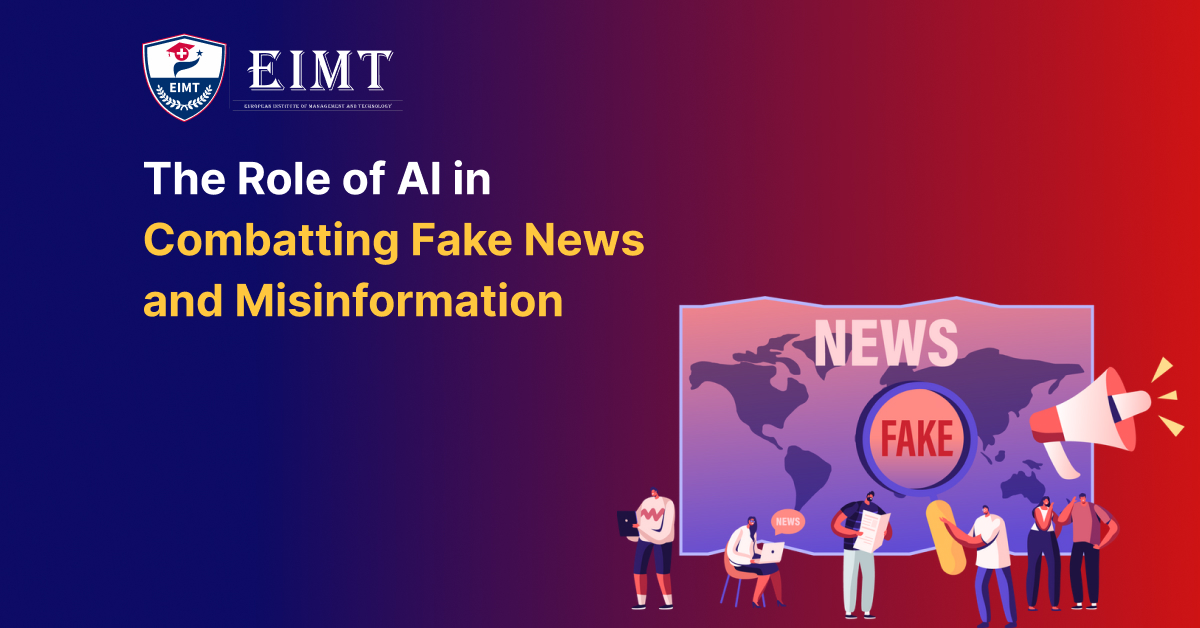
All Programs
- Switzerland Campus
School of Management
School of Computer Science
- Doctorate in Business Administration
Research Programs
- Bachelor of Business Administration
Bachelor's Programs

About EIMT
Student Zone
Switzerland Campus
About EIMT
Research
Student Zone
How to Apply
Apply Now
Request Info
Online Payment
Bank Transfer
Home / The Role of AI in Combatting Fake News and Misinformation
Artificial Intelligence
Dec 9, 2024
The spread of misinformation and fake news has increasingly become a critical issue recently, especially around big events such as the U.S. elections in 2020 and the COVID-19 pandemic. Misinformation regarding how the virus originated, treatments of the virus, and safety measures have emerged, along with false claims over the electoral process, which influenced public perception and even public health responses. Another type of harm to brand reputation comes from misleading narratives, like the ones connecting food chains like Chipotle to foodborne illnesses. Social media sites, which are intended to be engaging, have created echo chambers that amplify sensational content and allow misinformation to flourish. AI is now taking on a significant role in addressing these challenges by detecting and flagging false content/incident in real time. We will also review the ways through which AI-driven tools are curbing the spread of fake news and creating a better-informed society.
Misinformation can spread through organizations like a financial panic, eroding trust and loyalty quickly, often based on incomplete or false information. Even if a company isn’t in the public spotlight, misleading narratives can create division and disrupt internal cohesion. This is evident when false information fuels toxic behaviors like criticism, blame, and disengagement, as seen in a Leadership IQ survey where 59% of respondents expressed concern about fake news at work.

Trust is foundational to organizational success. Deloitte reports that 80% of employees who trust their employers are motivated, compared to just 30% of those who don’t. Trust boosts collaboration, productivity, and employee engagement, making misinformation a serious risk. It erodes psychological safety, stifles innovation, and hampers team performance. Ultimately, misinformation is not just a threat to a company’s reputation - it undermines its ability to function and thrive. Organizations must act quickly to safeguard both their internal and external trust.
Human instincts for sensational stories and emotional reactions significantly contribute to the fast spread of misinformation. Daniel Kahneman’s Thinking, Fast and Slow highlights how System One thinking - quick, intuitive decision-making - is susceptible to biases like confirmation bias. This makes it crucial to critically evaluate content that evokes strong reactions or uses inflammatory language. The 2018 MIT study underscores how easily false news spreads, with false stories being retweeted 70% more often than true ones, especially when shared by influential networks or written in sensational tones. In my view, this reinforces the importance of not just relying on human judgment but also leveraging AI to counter misinformation. AI, particularly transformer-based models like BERT, is a powerful tool in this fight. In 2023, BERT’s enhanced model achieved a 98% accuracy rate in detecting false news, demonstrating its potential. As misinformation becomes more sophisticated, AI will be indispensable in safeguarding both organizational integrity and societal trust.
Simply put, AI is a tool, not a human replacement for information misalignment.
AI plays a crucial role in combating misinformation by detecting false content in real-time using advanced tools like LLMs and fact-checking systems. However, it has limitations, including false positives and contextual misunderstandings, requiring human oversight to ensure accuracy and effectiveness in the fight against fake news.
Stay Connected !! To check out what is happening at EIMT read our latest blogs and articles.